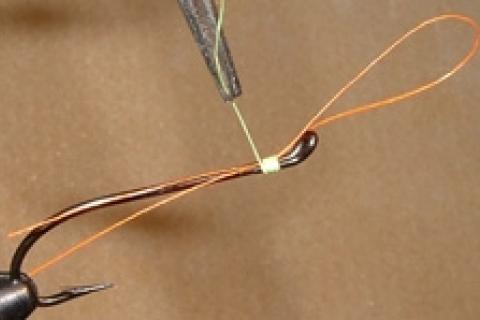
Whip finishing is a basic fly-tying skill that, once learned, you'll use on each and every fly pattern you tie. Learning to do it right is essential for creating durable flies that last longer than a few casts.
 The loop finish is a way of whip finishing a fly with a loop of line rather than with a whip-finishing tool or your fingers. By wrapping down this loop of line, you create a slip knot around the head of the fly — or anywhere else on the hook you wish to place a knot. Simply tighten the knot to bind the tag end of the thread to the hook shank to secure all your materials into place.
The loop finish is a way of whip finishing a fly with a loop of line rather than with a whip-finishing tool or your fingers. By wrapping down this loop of line, you create a slip knot around the head of the fly — or anywhere else on the hook you wish to place a knot. Simply tighten the knot to bind the tag end of the thread to the hook shank to secure all your materials into place.
Traditionally, whip finishes have been accomplished in two basic ways: using a whip finishing tool, such as the Thompson or Matarelli, or by hand.
Both the Thompson and Matarelli whip finishing tools work great if you invest some time practicing with them. Whip finishing by hand is popular, too. But since some of us don't have the most nimble hands, fly heads can sometimes turn out sloppy or loose. While the loop finish might not be the solution to all your finishing needs, it may be an easier method to learn initially.
Which method — tool, hand or loop — is better? While you'll likely find a great deal of debate on the subject, the truth is that it's simply a matter of preference. When applied properly, the loop finish will cinch all your materials tightly in place. A thin layer of head cement will add extra piece of mind, but it's not necessary. And a double loop finish, with four turns of thread, should hold up to all the abuse you can dish out.
Step-by-Step Instructions for the Loop Finish Fly Tying
|
Step 1 Cut a 3-inch section of 6/0 Uni-thread. (We've used orange thread here as it shows up better, but any color will do.) |
 |
|
Step 2 Place the hook into the vice, and tighten it securely in place. |
 |
|
Step 3 Attach the tying thread (chartreuse thread) to the hook shank behind the hook eye. |
 |
|
Step 4 Slide the loop (orange thread) underneath the thread wraps into position onto the top of the hook shank. |
 |
|
Step 5 Wrap the loop down with four turns of thread from you bobbin. |
 |
|
Step 6 Give some slack line with the bobbin and attach your hackle pliers to the thread. Cut the tying thread beneath the hackle pliers and bring the thread to the top of the hook shank. |
 |
|
Step 7 Hold the tag end of the thread with your left hand, and remove the hackle pliers. Place the tips of the hackle pliers through the thread loop (orange thread) and grab the thread once more. |
 |
|
Step 8 Slip the tag end of thread through the loop while maintaining pressure on the thread with the hackle pliers. |
 |
|
Step 9 Grab and pull the tag ends of the thread loop (orange thread) with your left hand until the tying thread in snug up against the thread wraps you made earlier. |
 |
|
Step 10 Give one more quick pull of the tag ends of the loop thread bringing the tying thread under the thread wraps. |
 |
|
Step 11 Pull up on the tying thread and cut it clean and short near the base of the thread wraps. Place a bit of thin head cement and allow cement to dry. |
- 3821 views

